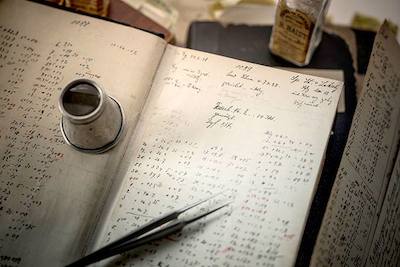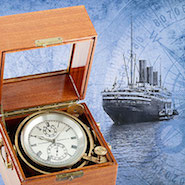Swatch Group’s Glashütte Original is looking back on 130 years of watchmaking through a marine-themed exhibit at the Glashütte German Watch Museum.
"Glashütte on Board – 130 Years of Marine Chronometers from Saxony,” opening June 17, focuses on innovation in timepieces that allowed sailors to more easily and more precisely chart their course, distance and speed. This exhibit traces the connection between the house's hometown and the Germany Navy, allowing Glashütte to celebrate its heritage through a specific lens.
Sailing through time
The exhibit, hosted at the museum co-founded by the Glashütte Original manufacture and the city of Glashütte, looks at the technical advances made by watchmakers including Fridolin and Paul Stübner, Gustav Gerstenberger and Herbert Weydig.
Before the invention of marine chronometers by John Harrison, navigation at sea relied upon the stars, with a chip log and baseline charted to measure distance and speed. With these new watches, sailors could more precisely measure longitude, an opportunity that came around the time the German Empire was established in 1871, creating more of a means for trade.
Not wanting to rely solely on English timepieces, the German government supported the production and development of marine chronometers within Saxony. Glashütte submitted the first chronometers to the German Navy for testing in 1886.
In the following 130 years, Glashütte has remained a key location for marine chronometer production, even with the advent of GPS technology.

Glashütte on Board exhibit
Following the first chronometers for the navy, Hamburg and Glashütte established a longstanding connection.
In 1875, the German Naval Observatory Hamburg was created as a center for chronometer testing, and the capital provided support for production of the watches in both cities from the 1930s. The astronomical observatory in Glashütte was also turned into a research center.
After Germany was reunited, this institute and tie between Glashütte were reinvigorated by Wempe Glashütte i/SA, and today the center holds manufacturing facilities and a testing area.
Glashütte’s exhibit tells the story through photographs, documents, exhibits and multimedia, taking visitors through the making of a chronometer as well as the practical uses of one of these timepieces at sea.
The exhibit will be up until Nov. 20.
For watchmakers, marine ties are a way to showcase their precision and innovation.
Richemont’s Officine Panerai reflected on its past and gave a glimpse at its future in an exhibit at Museo Marino Marini in Florence.
“Panerai – Dive Into Time” ran from May 18-21, with 10,800 square meters of exhibit space showing never before shown archival pieces, as well as a first look at the newest models from the brand. While it is important for heritage brands to look back on their history, museum exhibits can also provide a space to reaffirm their relevancy today and tomorrow (see story).
{"ct":"vRntEFYaPuGm7KSElNW4pn+dZwz1Na6nWl2bMV\/OliAMpYaqj+KrBPYrEwIfPDE41L3MjtdE6bgPZaRstQ4IzgOeTRB2VznoR6Sdz1vfM867aC7Ss+FKtyUQnG0y9awmBexUG68avLvWsXfnekGhzpU7e+aDkfL1KuS9DyTY\/0xOoInhM3cCfKGjQ4F3I53QqHVOgr+32e\/LTq7rZzjqH4tskPsqPVokVajC6tlus2TI5JDEK\/BiFIMszbLetpLRNpSffQtQsFUFjEIIUY6lZFQLNJBnRUYc73d\/XFstywrZTqaLFIGbZmfTKMtBpPtNVEw947kuFj2U62Q5ocsKtVp+kLU49IOAXHNXC3vP8RYthZYxqR2b0fpXIr1\/W0zWTgxvHxQfNsRDZl+y6LPRKOt2Da2WYt7c7myW4vf3iiusnFomoM1CF6fERRV+1nWb4v+oVonwpioJLwLt+1MvDMo09GM0XzIQ5ufiQ5SinPTq7MU+XqeaFaU2mbR97VBxpJmjhRWMwMcwqQVrvtnN0GsUTAM9CMzZxdzDgUG\/O0bYDSkRkJISdr+B0\/hgOWykjtlRLrvjSHXP4wsA6+NA3Bsc9Cad\/HuGNt\/NEDa3gqRQlQkKjNswjTn38BkVus+a6trgLfYDlY1EyiJVkC6WimiyA6Y+XDvlcO7gCFc15xShAOG7QrIHc7ELPntj9P\/Te\/XOLDK9\/oaZ01GpvnojjLXba5Kq\/JTGWVS0yfQ37h9abn38E4DQACtHRLWx04ZO4dagOI4OWc3CuFi7mNnaKU7ycQGmXyar3qL\/6kc65qNEJmppaQKOYQlD8CPmVdEzoQ2OFlnkmsRAWaWwdEt8flVxGfDn9D2kcoi3Eyc9XcaEWBt155HGjiuaWwJya5oI2Q6ML0EX7r0Lfnayl0omwV+h4VDu8NLizMayjVTbpBoPAKYcPF1GNpuIaqVVNTUi8NDTSR2clk2Ybj9rdAoPBf07ueqU0WIvTAcsFoo3DUa05xLPSfVHNB6JJnGuarq8oT1gU0ik5l93WBXuCwyTkmLLSdscN7mCLgoXmIN+khJ1viy+uC9HNgGNrkX+gedd9cJhmfUEb70k4eUC\/PSuIbLyb7zsXRKflajJ18vZ2beIel7DGHvPRqER7R3jdr9Z40YGUM6a5RepIR26KQg7rN8kUw2RzRsHtw23tUYQNZD\/JHniEb+iZmxBc59gOhOWTb07ZQjRidQooOXeJUyfFL0JPgPxFLQSo7ynr\/ZJAIE4zj0A5rP\/0c9VgHDd3VBvpc4tesaKE5WkV3ZdGtvtcvJrIZ7TMDn3vcc4FPcvf4Bo00jAZjhY7B29P2PmbPcCY1oC5eQ6\/Am\/ciGbV5Rp9Bj7Ww3FqI2zv5cvHrnIfhIlBIiyPr+q45OWN89RhOnejJ9OAqEb+J5vITm\/uP8wlpcn5VQsurZ+bqS3Ggnhogn9l\/CZn9OYAflTcf61yG+fDFkbtGEtZU9JpJdgvIBRYMPIrbQUDxKUHMel2ZZKWLoCTYbU4SqeoPzDDtITtQkP11DmVNhuCMmg6lVtFP57xkHgfeQBSZjUOcjfeeVYa5Y690dnU983vVpWFfcVuYuJEYMxQWa5tXlksGgEtItp1HAuChDzmh\/e+qJHYqNTxuQ5gD85UMPm3w2KB6NTuX1i5sAZoaAzPIlMz3mgu+pdcNkyKaVIpz48kNjXKxxJejisoz\/MJmtjnzrVtbKEvZQm9FPC22ngplSIsocnQL3JfOSzOkHQX9fjSqIN6MAW8Qj4PMuSw1MbMCCsQX33v4+7TNnaGYJDHLzkrNBN09EAeoQB\/SX+eLztEPvrVHhsgy3Z6GWIIIBU7JX9LJfe1jH4myvbo92TPNiidXIbw96fu7RK\/9IN7lwveKGDQQeQp1N\/zto7r18edlvUhyPixQbU9faRBmfa4CTqjyb7AHCoaIzO4E1uu+F8CashLvST1ZEiMUdiFJEuOPQic9Q81OlOkqq26\/8o2fMwA2lsorDdvdAUgdAYgguMf4Nna3LasoLNHOsALu7NrVqvgdaK28jfegNpet+jCfeYr9w0ELM\/56uJuIYG68Cey5StINl9H7\/Jzkk9BLc+yTgL07QK\/nyyFdb1P0mNXGXbd7YikMkQRxozqAB2KK5w23Ey3sZ5HloS1nUeDYVAkhC5OsBGKlAFO2Exll3ct1vA4WYbanifzqGMMIS7r0MM5if7jYpCTKUXuK4lRf10gNekNZGq6RbtbsemWHVa8Hw9q0dxsDg9n4m0F10RYeECVGWSgMh\/1DscmeFDAHlDBbTydVcnSPZC3+5n+2p5Bjzm\/PK9hfZ4\/KfUWpaZPLv\/D95VWgYH5oxFLVGnG4fsk8RDOurElLGAZbII\/NdJa1iM\/4pT5OlRMs5K91YLEKHilw8XO1cUf3f7xOReNMPPCAAgEb12yLQv+WqBNM+4M5vcZhqpL5J5vnfwfBJ6ehI84hS5tlhHeMxbBP8pVUuqAJifIa36hQC5zGKotAZtOiDP3DKkTJ7VBZ3iWtm6yvd1Q2L8Nw9eVt9UW58N4q58ZAL49IQqCKBFt13x5jsQ+A0A4aZRxZekELRNP\/g1bInMeIR8pTmD3WvQjymIDlVpmcvO\/Olb4X7jvbgNnGK\/kR6cJWbKAKcf7OSBZbtzzEaapjY5A3RhCNDZi5l4H0+ZkBsVzRIXDYxUAZQgPxx7L2g5Z69zcr\/nI+Aw5tdO4H5zssEjj6uaFCZbr3ehnCCAqnn+m+AJgQVVys\/jFPEdW2G8xOr3dIO37iY6Q9GjfLMY\/1J7kWn1RBi9Ngkb9bF3raLdD8VvvUg3yIiDIiaN7t7WrOSN8uywmCcYaogkak84mqSaOpyUbeGLeDf1gOSDKux+5UXrA2hJ7AIqOl1IL+Niti\/FzMt6iah3kG6yOSTsmUVzkEv0OOSuMeHoGa\/6XwcUIeb8M4Mly3jGo499FuhAFoIp+iFcbCx92WU3Jjy+4PT4F8jXM5xaDXXsfR6ZvOfw4+YOHAAbf4vHvO\/C8hqicXddaZVZPssxSAvRt9R\/j2J9cgR\/O5B6vDwzyyg3uDDoIyxz4G9CtAu3bFMbkyyqP+1aGSmumgAXdIXxJublYG5uor+nJp+QnnpiIK9zfAliGEvvF7NqrJvObiHbGa6xLp1IM2jstZv1qBE2Y7ywlRQze\/O1Au8KY06PfDbaN+czehl+2gOJtN4l5j55MB9Z3pvopE8bf3IcKgVud5tPhS4qHoUXJLH00M0OLDH\/HirJWV9OY8UXTRG8wEJpfDjFjQAuxQ6Vyb4huCF8OuB3UA0E7s+ZU0dHYubtDkf8ykyAnx6\/xuk6B8Y5uOqZcHocxyRR\/lNSiyj7zVwd8F3uZH9O9GrsIxMlKOj1gzAwp09oCTdQx1fzD90wZxizQtr2Ud+drFcV\/1Rma2TVjFMwY5g8K8Z5KGE8lLfUnbm\/OoU9hnLN58hq8kXrxQp0UzLt3bIra2QxugKXiDr1EcEE+8+6z\/imFwhI3maDzOxBrLV+7hhMmQzr\/DIxtUeVvqpkuiN8QDySgAw13YdHePLxRdIQ85x4K4UzRLyYqCl2Acq7RzZ0i\/HC8mphuXCNSiLDg49u3PtGaXwuISt7NJNNCeeqnd0QF8s0UzePdvd4qoLqcqwqbmEsJXR8qIn5DfC1RYcdxICP\/Dhmx5tSLhDJOhC6L87cxbwDUAeObGCcVZ8dWlt9YrllN3QJKtmRAYluMw+Qe+0gPCfTolxQ+jD4r5I+E2Vk0XxQCrrk38dosmsZyLToa+FwrXZA\/2hi1FnSMXJkS0fM4X9C8yKSriT1ZAz7YBXj06cE0UVVtHEreF3cPllTibELiCfAY2RwAxFe0TzanwZbEOrw2xtf83jtSs3lwNoe7UMO8pqlmNzyKDX\/nDA5T1gUqPw1koe85A\/1ITMM60NTBDcD5PQjUuki9TOADKgDelvxoTk2fSbXWni4S0KUJrWN92RjZEHDDNhb6xXF14zdIqHmAqaeWYEdIqE77Y728h0jZkJaiFZiDOIl91tFUnJQ4wTG1W6MJucHa2CL0Gxcgh26cVp7LyTYAuaIez79QDrjqwC9fyU2W8gqls8iNeOnNImkitWhT2H90fFRAv2qLMT0SpfwE6qFpu4y6iKfUcOfKULjDL1CpAZertJrDhPIM9fminM4ak5rpyfxjmE4WwqKBB7HmbkXLjnka+kTzwvag1tpeP06ceyX7yllrSpADRs1VzXGnwvIE1C06DQBWtOzKbimhnBHjG+F499SKaSHxdMLrSCACYRorf4baJ11pbCenKbi4C7Oi0H3zvxhTVrWuQaz0+557XZONjpo5\/f2o3825AzyAGBM9j63YxlaTM5\/GHfxXCwIy82nrFc9a5Tl8MUP66vZX8ty4YJsCH943AEGJMejf0IpLhCTuvWOsfzWEEgEdG8dA9R8xqJbXpbo2UugvE2VOQ0gV1CbkzsksNSX9TSGeOY7gQ947FdFPkPFza9kDUxd2g7Dgk0AqWFwBDFGN4UIQbLUamnUi1QhqlFq6LDNBFNl\/sJIQw21TMufTBsyM6b282pXykE1yhWFbEqYm2NrG2mfwccZwg5xK1I2gQGpnvMIOO7tIDe4XvTLkidaWqjY0Lmre5JLm+63xT8b0wQnpC++r+HIfhq7MQf3ZN6ZPnVrtMaW+\/BhrVkKzJvwY7WGB+e0ohNRKcDOxjCKkaiv1X3lszNtrktnYfuSg05T7U4YW\/0z8TsunZs6GGM+i97q3URII0jpSn\/xgsiqjK2bWEVolRXYrj1jeeyj6M7\/GKGF\/OL6lRGwnhqnFbqKV4vCgP3lcXjQYeM9850Rf74U+JUqkNxOTVsOa6Kk6VUEE4JXwurxM64fYBmiN7iC1V1kwwoNlkUKwYaep9LRDAPfdim\/n6iziIkdoLzN5XqlI0mPK7p0z6QPrXY\/vvql0QUkP4883i6PTPCdR07cPfOn+Lgak8LHNI9dFJmdN6X9CG2zqifkiiupHglzxw0oVX0lGLu78XzPYKy9dYPfRXQYV4oYOUAFPmTSNsnNw5mEVvs5wL95hjen9smOITg0aX1Q3RpbtpXOU6NfEP15nITJ\/cd4M6eFC9KM7Kh0VK\/OgcKoaC2XWIUwowbqR81Az1HwnybU7XhgUA==","iv":"c221092a2b0b2e865790f35ea2bed060","s":"cf0ebe9e028877ba"}

 The Glashütte on Board exhibit looks at the city's ties to sea travel
The Glashütte on Board exhibit looks at the city's ties to sea travel